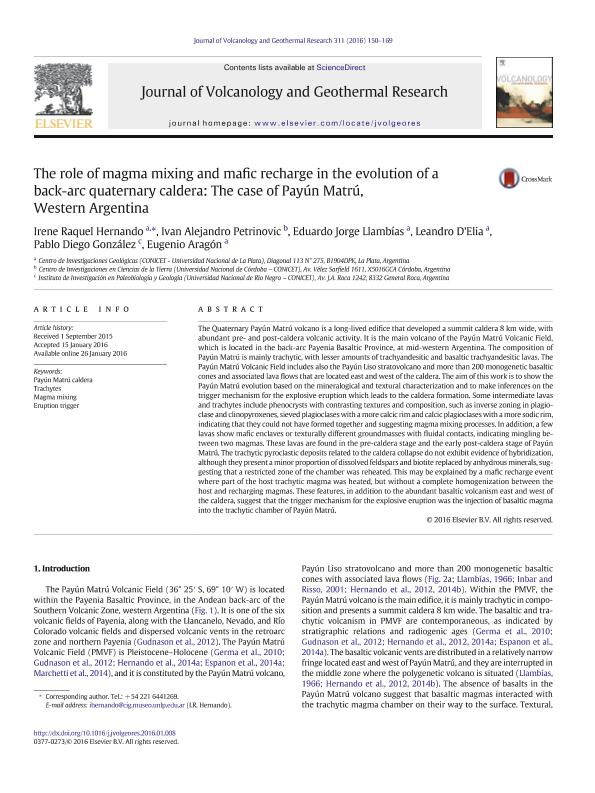Mostrar el registro sencillo del ítem
dc.contributor.author
Hernando, Irene Raquel

dc.contributor.author
Petrinovic, Ivan Alejandro

dc.contributor.author
Llambias, Eduardo Jorge

dc.contributor.author
D'Elia, Leandro

dc.contributor.author
Gonzalez, Pablo Diego

dc.contributor.author
Aragon, Eugenio

dc.date.available
2018-05-07T14:17:46Z
dc.date.issued
2016-02
dc.identifier.citation
Hernando, Irene Raquel; Petrinovic, Ivan Alejandro; Llambias, Eduardo Jorge; D'Elia, Leandro; Gonzalez, Pablo Diego; et al.; The role of magma mixing and mafic recharge in the evolution of a back-arc quaternary caldera: The case of Payún Matrú, Western Argentina; Elsevier Science; Journal of Volcanology and Geothermal Research; 311; 311; 2-2016; 150-169
dc.identifier.issn
0377-0273
dc.identifier.uri
http://hdl.handle.net/11336/44275
dc.description.abstract
The Quaternary Payún Matrú volcano is a long-lived edifice that developed a summit caldera 8 km wide, with abundant pre- and post-caldera volcanic activity. It is the main volcano of the Payún Matrú Volcanic Field, which is located in the back-arc Payenia Basaltic Province, at mid-western Argentina. The composition ofPayún Matrú is mainly trachytic, with lesser amounts of trachy andesitic and basaltic trachy andesitic lavas. The Payún Matrú Volcanic Field includes also the Payún Liso stratovolcano and more than 200 monogenetic basaltic cones and associated lava flows that are located east and west of the caldera. The aim of this work is to show the Payún Matrú evolution based on the mineralogical and textural characterization and to make inferences on the trigger mechanism for the explosive eruption which leads to the caldera formation. Some intermediate lavasand trachytes include phenocrysts with contrasting textures and composition, such as inverse zoning in plagio clase and clinopyroxenes, sieved plagio clases with amore calcic rim and calcic plagio clases with a more sodic rim,indicating that they could not have formed together and suggesting magma mixing processes. In addition, a few lavas show mafic enclaves or texturally different groundmasses with fluidal contacts, indicating mingling between two magmas. These lavas are found in the pre-caldera stage and the early post-caldera stage of Payún Matrú. The trachytic pyroclastic deposits related to the caldera collapse do not exhibit evidence of hybridization,although they present a minor proportion of dissolved feldspars and biotite replaced by anhydrous minerals, suggesting that a restricted zone of the chamber was reheated. This may be explained by a mafic recharge event where part of the host trachytic magma was heated, but without a complete homogenization between thehost and recharging magmas. These features, in addition to the abundant basaltic volcanism east and west of the caldera, suggest that the trigger mechanism for the explosive eruption was the injection of basaltic magma into the trachytic chamber of Payún Matrú.
dc.format
application/pdf
dc.language.iso
eng
dc.publisher
Elsevier Science

dc.rights
info:eu-repo/semantics/openAccess
dc.rights.uri
https://creativecommons.org/licenses/by-nc-sa/2.5/ar/
dc.subject
Payun Matru Caldera
dc.subject
Trachytes
dc.subject
Magma Mixing
dc.subject
Eruption Trigger
dc.subject.classification
Meteorología y Ciencias Atmosféricas

dc.subject.classification
Ciencias de la Tierra y relacionadas con el Medio Ambiente

dc.subject.classification
CIENCIAS NATURALES Y EXACTAS

dc.title
The role of magma mixing and mafic recharge in the evolution of a back-arc quaternary caldera: The case of Payún Matrú, Western Argentina
dc.type
info:eu-repo/semantics/article
dc.type
info:ar-repo/semantics/artículo
dc.type
info:eu-repo/semantics/publishedVersion
dc.date.updated
2018-05-02T17:40:57Z
dc.journal.volume
311
dc.journal.number
311
dc.journal.pagination
150-169
dc.journal.pais
Países Bajos

dc.journal.ciudad
Amsterdam
dc.description.fil
Fil: Hernando, Irene Raquel. Consejo Nacional de Investigaciones Científicas y Técnicas. Centro Científico Tecnológico Conicet - La Plata. Centro de Investigaciones Geológicas. Universidad Nacional de La Plata. Facultad de Ciencias Naturales y Museo. Centro de Investigaciones Geológicas; Argentina
dc.description.fil
Fil: Petrinovic, Ivan Alejandro. Consejo Nacional de Investigaciones Científicas y Técnicas. Centro Científico Tecnológico Conicet - Córdoba. Centro de Investigaciones en Ciencias de la Tierra. Universidad Nacional de Córdoba. Facultad de Ciencias Exactas Físicas y Naturales. Centro de Investigaciones en Ciencias de la Tierra; Argentina
dc.description.fil
Fil: Llambias, Eduardo Jorge. Consejo Nacional de Investigaciones Científicas y Técnicas. Centro Científico Tecnológico Conicet - La Plata. Centro de Investigaciones Geológicas. Universidad Nacional de La Plata. Facultad de Ciencias Naturales y Museo. Centro de Investigaciones Geológicas; Argentina
dc.description.fil
Fil: D'Elia, Leandro. Consejo Nacional de Investigaciones Científicas y Técnicas. Centro Científico Tecnológico Conicet - La Plata. Centro de Investigaciones Geológicas. Universidad Nacional de La Plata. Facultad de Ciencias Naturales y Museo. Centro de Investigaciones Geológicas; Argentina
dc.description.fil
Fil: Gonzalez, Pablo Diego. Universidad Nacional de Río Negro. Sede Alto Valle. Instituto de Investigaciones en Paleobiología y Geología; Argentina
dc.description.fil
Fil: Aragon, Eugenio. Consejo Nacional de Investigaciones Científicas y Técnicas. Centro Científico Tecnológico Conicet - La Plata. Centro de Investigaciones Geológicas. Universidad Nacional de La Plata. Facultad de Ciencias Naturales y Museo. Centro de Investigaciones Geológicas; Argentina
dc.journal.title
Journal of Volcanology and Geothermal Research

dc.relation.alternativeid
info:eu-repo/semantics/altIdentifier/doi/http://dx.doi.org/10.1016/j.jvolgeores.2016.01.008
dc.relation.alternativeid
info:eu-repo/semantics/altIdentifier/url/https://www.sciencedirect.com/science/article/pii/S0377027316000184
Archivos asociados
